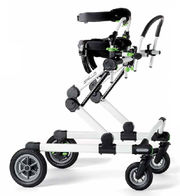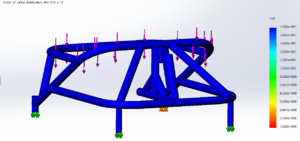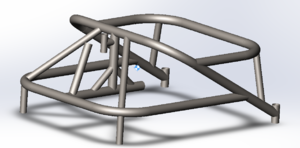Advanced Walker
Contents |
Abstract
A young child with Angelman's syndrome needs help walking. The child can walk with assistance, and we plan to make or modify a walker. The walker needs to support some of his weight and aid in keeping the child's legs forward. The child will not use handlebars or pedals, and can only pull up to his knees.
Team members
- Group Members: (from left to right) Nathan Parkison, Logan Hunter Watson, Celeste Conaway, Ashton Dement, and John Philip Nelms
We also received assistance from Heather Craig, the child's therapist, and Mark Davis welder of the Frame. Special thanks to Jeff Randolf for his assistance in the shop.
Problem Statement/overview of the need
A young child with Angelman's syndrome needs help walking. The child can walk with assistance, and we plan to make or modify a walker. The walker needs to support some of his weight and aid in keeping the child's legs forward. The child will not use handlebars or pedals, and can only pull up to his knees.
Design Specifications
- Material: PVC or thin wall aluminum
- Support 100 lbs
- Weigh Under 20 lbs
- Adjustable height to grow with child
- 3 or 4 wheels (wheels to roll on carpet at home)
- Large, thin, caster wheels
- Soft covering (child has seizures/faints)
Background Research
1.There are quite a few child walkers on the market today. The main difference between these walkers is how the child is supported. Some walkers allow the child to support themselves while others support the child almost entirely. Some similarities with walkers on the market are the wheels and material. Most walkers use four wheels and appear to be made out of aluminum tubing or other lightweight metal. There aren't many products similar to what we are looking to design.
2. We could not find a walker that could provide aid while walking with the correct leg position that did not require the use of handlebars. With our project, we need to make a walker that helps the child walk while correcting his leg position.
3. One gap that we noticed was the cost. Some of the walkers we found were somewhere between 500 to 1000 dollars. This may not sound too expensive initially, but as the child grows the walker will eventually become too small to be effectively used. Then the family will have to purchase a new walker. Another gap we found was that many of these devices were very restrictive. With our project, we need to design the walker to be the opposite and allow the child to move freely with the device.
Conceptual Design
Design Concept 1: Push Cycle
- Description: Four-wheeled cycle with adjustable seat height, handlebar angle, and height, seat tilt, body support angle and height, detachable boundaries to help keep feet straight on middle and sidebars, with the tie-rod steering mechanism.
Design Concept 2: Mobility Buggy
- Needs: A mobility buggy would serve as a combination of a standard mobility walker with something a bit more fun. The buggy would have four caster wheels so that the child could easily make turns and navigate a room. The frame would need to be light so that the child could easily push it.
- Design: To accomplish this, the frame would need to be made of a material such as carbon fiber or aluminum. The child has not yet developed the ability to support himself on two legs, so a back and upper body brace would be very helpful. Handlebars, and some type of leg boundary, when paired with those supports, could serve to help the child get used to walking. Until the child is able to stand without active support from another person, the child would need to be placed into this buggy
Design Concept 3: Bungee Walker
- Description: A tubular frame with 4 large casters. The frame has a midsection with elastic bands attached to support the seat.
Evaluate concepts/select candidate
Estimates of performance and some calculations needed to analyze concepts
Use a decision matrix or similar tool to compare designs against project specifications
Discuss winning candidate
| Specs | Design 1 | Design 2 | Design 3 |
|---|---|---|---|
| Material | Aluminum | Aluminum | PVC |
| Estimated Cost ($) | 150-200 | 150-200 | 100-150 |
| Weight (lb) | 15 | 15-20 | 15-20 |
| Functionality | Easy for the child to use | Hard for the child to use | Easy for the mom to use |
Detailed Design
Description of selected design
The final design has become a combination of all three of our original designs. The walker will have four wheels that can swivel freely. The walker will have a type of bungee seat that the child sits in. Instead of having handlebars, initially, we will attach a plastic table. The child has trouble holding onto things and the table will take that into account. Once the child is older, the table can be removed and handlebars can be added.
The frame will be made out of 4130 steel. This will keep the cost down, and be much easier to work with and modify. The weight will also be able to be kept around our 10-pound goal.
Analysis
Shown are the FEA results of the Analysis. Hand calculations for Roll-Over Analysis and stress-strain were performed by hand and seemed consistent with the FEA results.
Engineering analysis 1
- The analysis was done in SolidWorks to determine the Factor of Safety.
- The analysis setup was with a distributed weight across the top of the frame with fixtures at the bottom stems for the casters.
- A minimum FOS of 17 was found through this simulation
Engineering analysis 2
Using the mass properties of the frame with 4130 Steel, 1"OD, 0.035" Wall Thickness
Center of mass from origin: ( inches )
X = 0.00
Y = -4.44
Z = -3.45
Engineering analysis 3
We also used mass properties in SolidWorks to estimate a total weight.
Mass Properties of Assm1:
- Configuration: default
- Coordinate System: default
Mass=10.72 lbs
Volume=126.29 cubic inches
Surface Area= 1652.48 square inches
CAD Drawings
Bill of Materials
| Item | Description | Price | Quantity | URL for Purchasing | Total |
|---|---|---|---|---|---|
| Easy-to-Weld 4130 Alloy Steel Round Tube 0.035" Wall Thickness, 1" OD | PID: 10751 from Online Metals (8ft length) | $41.96 | 2 | https://www.mcmaster.com/#89955k339/=19xhzly | $83.92 |
| Seat | From Exersaucer Door Jumper | $19.98 | 1 | https://www.walmart.com/ip/Evenflo-ExerSaucer-Doorway-Jumper-Owl/42338088 | $17.99 |
| Threaded-Stem Caster with 5" Diameter Nylon Wheel | Locking Swivel Casters 5" Diameter | $12.98 | 4 | Amazon- Service Casters | $51.92 |
| Tray for Walker | Tray for snacks and drink from Target | $19.99 | 1 | https://www.target.com/p/baby-jogger-child-tray-single-snack-tray-city-select/-/A-15138630#lnk=sametab | $19.99 |
| Powder | Orange Powder Coating- Columbia Powder | $13.23 | 1 | Columbia Powders | $13.23 |
| Padding | Pipe Insulation | $2.23 | 2 | https://www.lowes.com/pd/Frost-King-1-in-x-6-ft-Foam-Plumbing-Tubular-Pipe-Insulation/3133247 | $2.23 |
Total ~ $190.16
Assembly Instructions
No assembly by the user required. The walker is pre-assembled.
Fabrication Process
- IMG
3D Printing Strap Constraints
- IMG
Wheel Guards
- IMG
Raising Walker
Testing and implementation
- The frame was tested by Dr. Canfield, who supported himself with the walker. The frame supported the load, which was much higher than the child's 25lbs, proving that it should support the weight of the child or even an adult if something goes wrong. The frame was also looked over for sharp edges and other hazards, but no issues arose.
- We will deliver the fame to the family at the earliest time possible so that the child can begin to use the walker.
Photos of Completed design
Final Product. There will be padding added to the frame in some areas.
Instructions for safe use
The child will be placed in the seat, facing the tray. The child will then be able to stand, partially supported by the seat, and move him/herself with their feet on the floor. If the child needs to stay in the same place, lock the casters to prevent unwanted movement.
Do not use the device unless supervised by an adult that has been fully understood the safe use of this product.
Project Summary, Reflection
This project has proven itself to be a unique experience in designing and manufacturing product to specifically help a child in need. From many different ideas and designs, we have found a solution that meets the specific needs of the child at an affordable cost. The child will soon be able to develop skills in walking and standing. This will allow him to take part in all the activities exclusive to those that can walk. In retrospect, the design process went very smoothly. Our team functioned well and each member had something to bring to the table. The design did shift from the early designs due to cost, manufacturability, and time constraints of the project. The design goals were accomplished with our design because the walker would help the child and be fun to use.




















